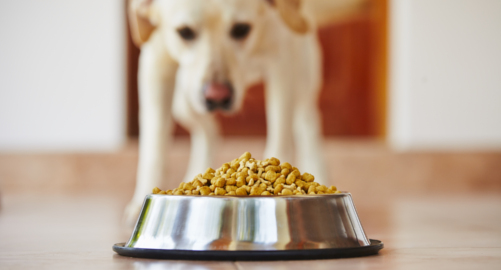
15-20% of itchy skin cases are due to a food allergy. Understanding why adverse reactions occur is the first step in addressing the issue.
Allergy vs intolerance
A food allergy is an immune system response, whereas food intolerance occurs due to an inability to digest a specific food.
Intolerance may be due to the lack of a digestive enzyme – as with lactose intolerance – or caused by a toxic substance. Dietary indiscretion in dogs is common; that's to say they may ingest an inappropriate item, such as a sock! Or go through the bin and eat food contaminated with bacteria. Food intolerance will occur on first exposure to that food or additive.
With allergies, the immune system regulates the reaction and several exposures are required before clinical signs will be seen. Allergic reactions occur when an individual who has produced antibodies in response to an innocuous antigen, or allergen, subsequently encounters the same allergen.
Symptoms
Symptoms of adverse food reactions in dogs tend to manifest in the skin or digestive system. Food intolerances often mimic allergies, but on balance, intolerances present more often as digestive upset and food allergies as inflamed and itchy skin. This is known as pruritis and can be localised – for example a recurrent ear infection, or more generalised in nature. Dogs with inflamed skin will often self-traumatise and get a secondary bacterial or yeast infection that may compound the problem.
Food intolerance often presents as digestive upset – vomiting, diarrhoea or an increased frequency of bowel movements. Sudden onset, severe allergic symptoms, associated with anaphylaxis in humans, is generally not a feature of adverse food reactions in dogs.
Most protein containing foods have the potential to induce an allergic reaction in a predisposed animal. A dog will not be allergic to a totally new protein source. As described above, it is after repeated exposure that the misguided immune system creates increasing levels of antibodies and the allergic reaction intensifies over time.
Diagnosis
The exact prevalence of food allergy in dogs remains unknown but a review, by Olivry and Mueller, looked at 28 papers published between 1990 and 2015 on food allergic skin reactions in dogs. The authors concluded that approximately 5% of all skin cases and 15-20% of itchy skin cases were due to food allergy.
A reliable diagnosis of food allergy can only be made when dietary elimination of the trigger allows the symptoms to resolve, and the symptoms return when challenged once again with that trigger. Your vet will talk you through this process if they suspect a food allergy.
Treatment
Treatment for food allergies and intolerances consist of avoiding the offending food component. Different Dog only ever use a single source of meat protein and there are no known allergens, grain or dairy in any of our recipes, to help your dog avoid any food components that they may be intolerant or allergic to. https://www.differentdog.com/shop.html#Our+Range



